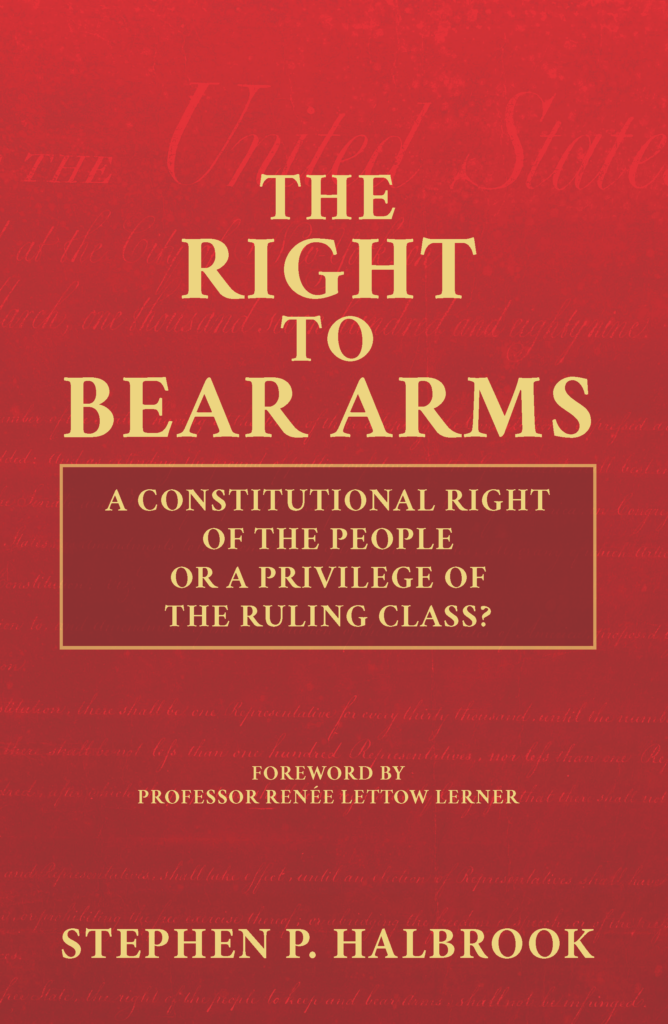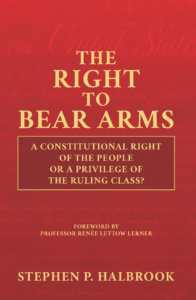
The Right to Bear Arms: A Constitutional Right of the People or a Privilege of the Ruling Class?
by Stephen P. Halbrook
Published by Bombardier Books (2021)
SUMMARY
This is the first scholarly study of the history of the right to bear and carry arms outside of the home, a right held dear by Americans before, during, and after the Founding period; it rebuts attempts by anti-gun advocates to rewrite history and “cancel” the Founding generation’s lived experiences bearing firearms.
The U.S. Supreme Court has recognized the individual right to keep and bear arms, but courts in states that have extreme gun control restrictions apply tests that often balance the right away. This book demonstrates that the right peaceably to carry firearms is a fundamental right recognized by the text of the Second Amendment and is part of our American history and tradition.
Halbrook’s scholarly work is an exhaustive historical treatment of the fundamental, individual right to carry firearms outside of the home. Halbrook traces this right from its origins in England though American colonial times, the American Revolution, the Constitution’s ratification debates, and then though the antebellum and postbellum periods, including the history surrounding the enactment of the Fourteenth Amendment to the U.S. Constitution.
CONTENTS
Introduction
Prologue: “The Right of the People to…Bear Arms”
Part I: English Origins of the Individual Right to Bear Arms
1. To Go Armed
2. “That the Subjects Which Are Protestants, May Have Arms for Their Defense”
3. A Right for All Seasons
Part II: The Fundamental Right to Bear Arms at the American Founding
4. From Colonies to Independent States
5. Adoption of the Right to Bear Arms in the Second Amendment
Part III: The Right to Bear Arms in the Nineteenth Century
6. Going Armed in the Early American Republic
7. The Fourteenth Amendment and Its Aftermath
Part IV: History Marches On
8. The “Wild West,” Jim Crow, and Anti-Immigrant Aberrations
9. From the State Courts to the U.S. Supreme Court
10. Today’s Limbo Game: How Long Can the Standard Go?
Afterword
The Right to Bear Arms: A Constitutional Right of the People or a Privilege of the Ruling Class?
by Stephen P. Halbrook
Published by Bombardier Books (2021)
SUMMARY
This is the first scholarly study of the history of the right to bear and carry arms outside of the home, a right held dear by Americans before, during, and after the Founding period; it rebuts attempts by anti-gun advocates to rewrite history and “cancel” the Founding generation’s lived experiences bearing firearms.
The U.S. Supreme Court has recognized the individual right to keep and bear arms, but courts in states that have extreme gun control restrictions apply tests that often balance the right away. This book demonstrates that the right peaceably to carry firearms is a fundamental right recognized by the text of the Second Amendment and is part of our American history and tradition.
Halbrook’s scholarly work is an exhaustive historical treatment of the fundamental, individual right to carry firearms outside of the home. Halbrook traces this right from its origins in England though American colonial times, the American Revolution, the Constitution’s ratification debates, and then though the antebellum and postbellum periods, including the history surrounding the enactment of the Fourteenth Amendment to the U.S. Constitution.
CONTENTS
Introduction
Prologue: “The Right of the People to…Bear Arms”
Part I: English Origins of the Individual Right to Bear Arms
1. To Go Armed
2. “That the Subjects Which Are Protestants, May Have Arms for Their Defense”
3. A Right for All Seasons
Part II: The Fundamental Right to Bear Arms at the American Founding
4. From Colonies to Independent States
5. Adoption of the Right to Bear Arms in the Second Amendment
Part III: The Right to Bear Arms in the Nineteenth Century
6. Going Armed in the Early American Republic
7. The Fourteenth Amendment and Its Aftermath
Part IV: History Marches On
8. The “Wild West,” Jim Crow, and Anti-Immigrant Aberrations
9. From the State Courts to the U.S. Supreme Court
10. Today’s Limbo Game: How Long Can the Standard Go?
Afterword

